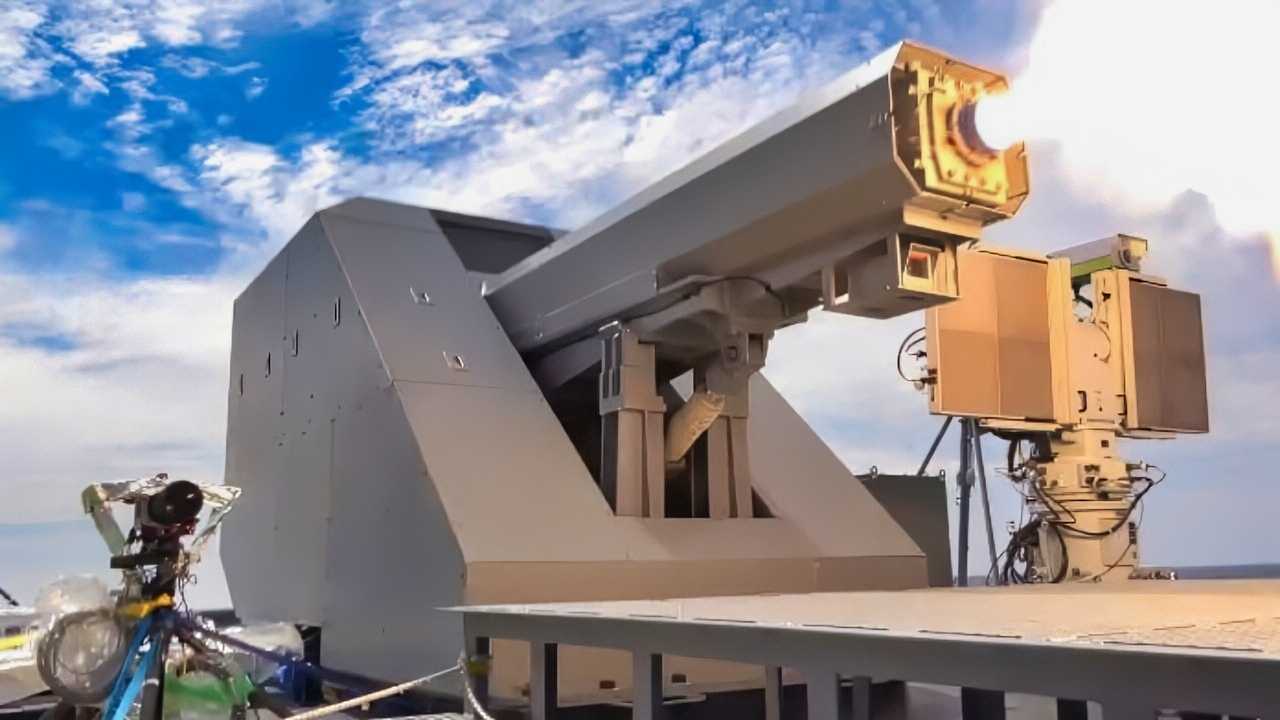Key Points and Summary – Despite years of Houthi missile and drone attacks in the Red Sea, not a single U.S. Navy ship has been hit, demonstrating the effectiveness of the military’s layered defenses.
-Reflecting on the campaign, Rear Adm. Kavon Hakimzadeh stated that while U.S. weapons and sailors performed flawlessly, the engagements highlighted the critical challenge of “magazine depth”—the risk of running out of expensive interceptors to counter cheap drone swarms.

U.S. Navy Railgun Test. Image Credit: Creative Commons.
-The combat, which included the first-ever air-to-air kill by an EA-18G Growler, has reinforced the Navy’s urgent need for directed-energy (laser) weapons to create an “infinite magazine.”
The Red Sea Fight Exposed One Big Problem for the U.S. Navy
The U.S. Navy claims a flawless record of destroying Houthi missiles and drones with its guns, fighter jets, and interceptor in the Red Sea.
But the Houthis have hit some civilian boats, and it is fair to wonder how close Navy warships have come to being hit.
It is a difficult question to answer, but most important to note is that after months, folding into years, of Houthi hostility in the Red Sea, not a single Navy ship has been hit.
Drones, cruise missiles, and some small boats have attacked Navy assets.
The service’s expanding defensive efforts have involved ship-based command and control, vertical launch system-fired interceptor weapons, deck-mounted guns, electronic warfare, and fighter jets that assist with targeting and shooting down aerial drones.
Houthi Attacks Hit Civilian Mariners
“I witnessed strikes from both crewed and uncrewed aircraft, observed warships defending against air and surface threats, and watched two rescues of civilian mariners from merchant ships struck by Houthi missiles,” Rear Admiral Kavon ‘Hak’ Hakimzadeh, Commanding officer of Carrier Strike Group 2, wrote in an essay reflecting on his combat experience.
Certainly the combat was serious; Navy warships came under attack on a regular basis for a considerable period of time. The overall experience verified the effectiveness of the Navy’s modern weapon systems, reinforced emerging doctrinal concepts about multi-domain targeting, and highlighted the effectiveness of Navy sailors and maritime warriors.
Amid steady threats, sailors quickly became quite adept at intercepting incoming Houthi drones using the full range of defenses, from Aegis radar, airborne fighter jets, and satellites, to ship-based command and control.
Shooting Down Drones: The U.S. Navy Needs Help
Hakimsadeh told me in 2024 that the Navy has been analyzing lessons learned from the campaign against the Houthis and exploring new weapons applications and concepts of operation to prepare for future drone and missile threats against their ships and other assets.
One of Hakimsadeh’s key points was that magazine depth was extremely important to the kinetic counter-drone fight, given the threats posed by large swarm attacks.
Projectiles, bullets, and interceptors are needed in great numbers to blanket an area with defensive fire.
Precision and multi-domain command and control are also critical; Hakimsadeh explained that surface warships were able to interface with ground- and air-based command and control nodes to verify targets, track threats, and intercept attacks.
The Navy learned new methods of countering drones as attacks continued in the Red Sea, and Hakimsadeh was clear that they would quickly be applied to the growing counter-drone fight.
“How do we expand the options that a sailor has to be able to take care of a drone? And I think in the near term, it’s probably going to be something along the lines of a gun system or a kinetic way to do it with guns and ordnance,” Hakimsadeh told me back in 2024 upon returning from the Red Sea. “But in the long term, I’d love to see things like directed energy, you know, something that can just recharge and give you that almost infinite magazine size, right? You don’t have to worry about your magazine size, because if you can keep generating the power to be able to launch your directed energy, if you will. “
Hakimsadeh said maritime warfare operations against Houthi attacks in the Red Sea involved a first-time combat use of upgraded variants of several key weapons systems.
“Our training works and our doctrine works. The CNO says it all the time: our people are the secret weapon,” Hakimzadeh told me at the USS Laboon’s (DDG-58’s) 2024 homecoming in Norfolk.
“They reacted the way they were supposed to and the weapons systems responded the way they were supposed to. We knew everything was going to work but we got real world experience—it’s a starting point to move on to the next level,”
The combat “firsts” achieved in the Red Sea by Hakimzadeh’s Carrier Strike Group were extensive, including the first air-to-air engagement by an EA-18G Growler and the first combat employment of upgraded weapons such as the AGM-154C JSOW glide bomb, the AGM 114K Hellfire, and the AGM-88E AARGM anti-radiation missile designed to destroy enemy air defenses.
Hakimzadeh also described new tactics and concepts of operation, such as the first “surface-to-air engagement of a hostile unmanned aerial vehicle by a U.S. warship.”
About the Author: Kris Osborn
Kris Osborn is the President of Warrior Maven – Center for Military Modernization. Osborn previously served at the Pentagon as a highly qualified expert in the Office of the Assistant Secretary of the Army—Acquisition, Logistics & Technology. Osborn has also worked as an anchor and on-air military specialist at national TV networks. He has appeared as a guest military expert on Fox News, MSNBC, The Military Channel, and The History Channel. He also has a Masters Degree in Comparative Literature from Columbia University.
More Military
Nimitz-Class Aircraft Carrier USS Carl Vinson Has a Message for the U.S. Navy
The Navy’s New DDG(X) Destroyer Looks Like a Missile and Laser Machine
Germany’s Big F-35 Fighter Purchase Comes Down to 1 Word
Eurofighter Typhoon vs. JAS 39 Gripen E: Who Wins Summed up in 4 Words
JAS 39 Gripen E vs. Dassault Rafale Fighter: Who Wins in a Fight Summed Up in 4 Words










